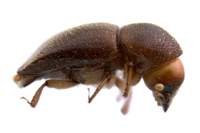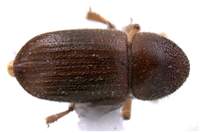Diagnosis
Elytra extremely flattened and prolonged posterolateraly. Protibiae narrow, with large denticles on all tibiae. Submentum large and distinctly triangular, flush with genae, pronotum extended anteriad, without serrations on anterior edge.
Similar to Leptoxyleborus, except submentum flat, elytral delcivity covered with erect setae instead of star-shaped scales, and tibiae narrow, with less than 5 denticles.
Distribution
Single known species A. puer, South Asia and Melanesia.
Biology
Unknown. It is not even known whether A. puer is a fungus-growing ambrosia beetle, or a phloem-feeder, a possibility suggested by its morphological resemblance to Dryocoetina.
Taxonomy
Shares many characters with Dryocoetini (flat submentum, ventral side of head long, resembling short rostrum, narrow tibiae with few large tubercles in enlarged sockets, pronotum conical and dorsally flattened). Its placement in Xyleborini requires further scrutiny.
Detailed description
Eyes shallowly emarginate, upper part of eye smaller than lower part. Antennal club appears taller than wide, club type three (with segment 1 straight or convex). Edge of segment 1 of club straight (may be slightly concave or convex) on anterior face, its margin clearly costate all around antenna, or mostly costate, softer on posterior side. Segment 2 visible on both sides of club, with narrow corneous part on anterior side. Segment 3 visible and dominant on both sides of club. Segment 1 of antennal funicle about as long as pedicel, its base stalk-like, funicle 4-segmented, scapus regularly thick. Frons above epistoma alutaceous, punctate. Submentum flat, flush with genae, shaped as a distinct large triangle. Anterior edge of pronotum with no conspicuous row of serrations. Pronotum from lateral view low and rounded (type 1), or elongated, with low summit (type 7). From dorsal view conical (type 0), or long conical (type 5). Pronotal disc shining with small setae-bearing punctures, shining part surrounded by asperate areas laterally. Lateral edge of pronotum obliquely costate. Procoxae narrowly separated, prosternal posterocoxal process tall and pointed. No signs of either mesonotal or elytral mycangia or associated tufts. Scutellum flat, flush with elytra. Elytral bases straight, with oblique edge. Elytral disc with punctures in strial lines. Elytral disc and declivity intergrading, disc is convex. Elytral declivity distinctly long and flat, very gradually descending, broadened laterally and elongated apically. Elytra covered with short abundant setae and flat scales. Posterolateral declivital costa oblique and broad, ending in 7th interstriae. No tubercles on elytra. Striae and interstriae on upper part of declivity flat, first interstriae parallel. Protibiae very slender, no granules on posterior side. Protibial denticles large, distinctly longer than wide, bases of denticles distinctly enlarged, conical, 4 or 5 denticles present. Pro- and metatibiae also with large socketed denticles. Uniformly light brown. Body length 2.9-3.2 mm.


